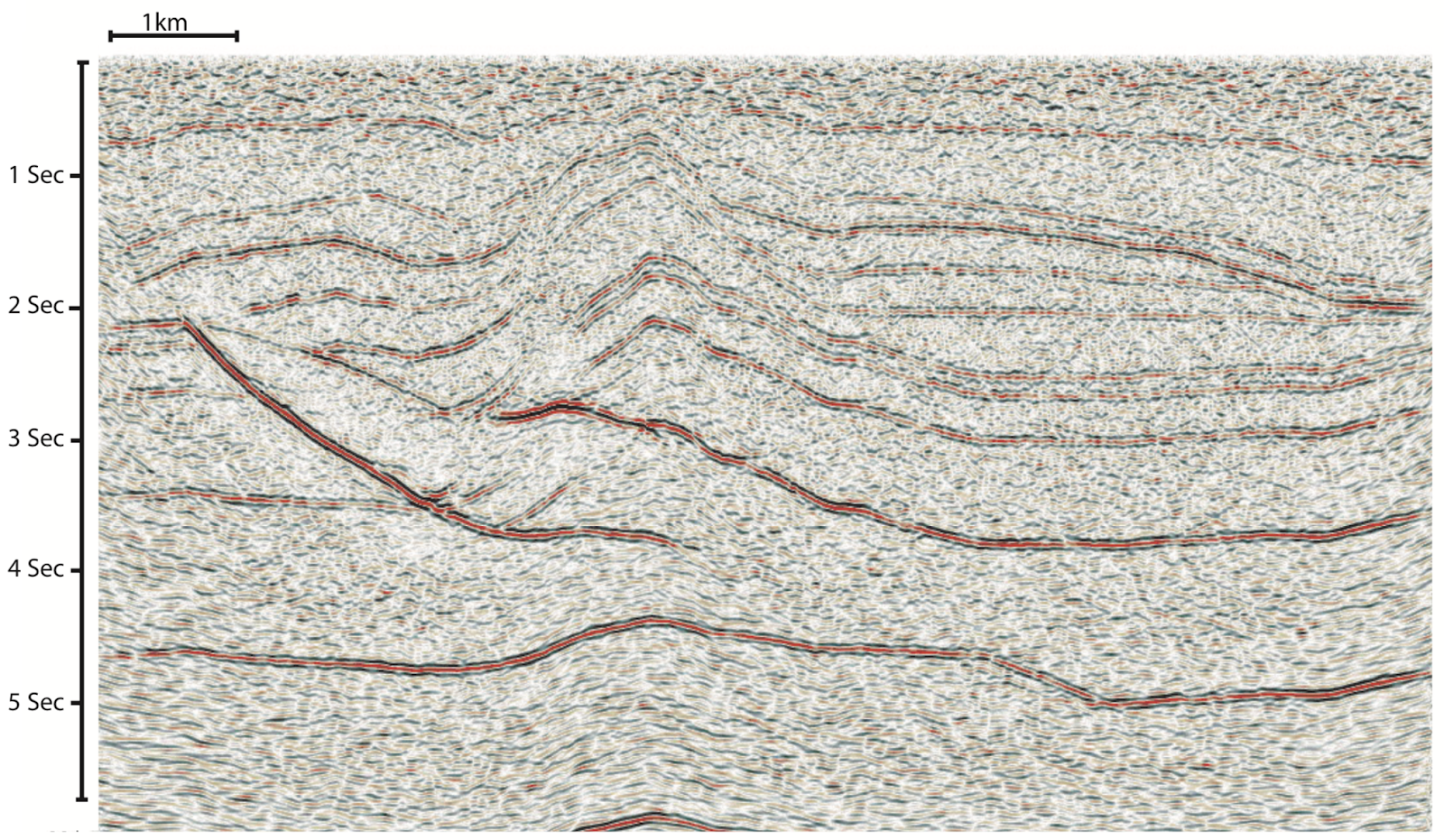
The Must-Read paper by Bond et al. (2007) is a truly original piece of work, focusing on the conceptual uncertainty that occurs when earth scientists carry out a geological interpretation on data with limited resolution and/or spatial coverage. In this example it is about an interpretation of seismic reflection data (Fig. 1), but it can be applied to other situations as well. Conceptual uncertainty refers to the bias that results from a geologist’s range and experience in applying certain (geological) concepts, and had not been previously quantified until this paper. The authors produced a hypothetical seismic section from a numerical model (Fig. 1), so that it would have a ‘correct’ tectonic scenario.
Now if you want to test yourself, try to make a geological interpretation of Fig. 1 before reading on.

Fig. 1 What do you think this is? An uninterpreted seismic section from (Bond et al., 2007). See the full paper for background and the ‘correct’ interpretation.
The correct scenario in this case was a tectonic inversion: a period of extension and normal faulting followed by a period of compression, folding and thrust faulting. Out of the 412 geologists that were asked to make the interpretation, only 21% decided on the correct scenario. Interestingly, it did not seem to matter what the experience level of the geologist was, with students scoring a similar percentage as geologists with over a decade of experience. In some cases, geologists were biased by their expertise. Compared to the average percentages, they were more likely to identify the features they would normally study, or identify that the section was definitely different from what they would normally study. However, the best predictive indicator for making a correct interpretation was neither experience, nor type of tectonic expertise, but the amount of techniques used. The surveyed geologists used between 1 and 4 techniques, and those using more interpretative techniques would be more likely to get the right answer than those using fewer techniques.
The authors point out that the data suggests that multiple factors play a role in conceptual uncertainty, and to have more robust results, a multivariate statistical analysis with more participants should be carried out. Also the chosen model and type of questioning may have introduced some bias. The most recent tectonic phase tends to be the most obvious one in most types of geological datasets, and by creating a scenario in which compression/thrusting occurred after a period of extension, people were more likely to point out compression as the dominant tectonic scenario. Yet, these initial results are thought-provoking, and opened the door to a series of follow-up papers exploring conceptual uncertainty (e.g. Bond, 2015; Perez-Diaz et al., 2020).
The authors point out how quantifying conceptual uncertainty may have important consequences in terms of risk evaluation, resource management and global warming. The implications of this paper are also relevant for education and training, as it helps to optimise strategies to acquire important geological skills. Some of the ideas of this work are considered in the development of machine learning techniques (Dramsch, 2020; Liu et al., 2020), for which it will be crucial to identify how geological concepts translate to interpretation, and how to quantify uncertainty. To conclude, we point out that this paper is a beautiful example of opening new research avenues by bridging two seemingly unrelated disciplines, as it introduces concepts from psychology like anchoring bias, (dis)conformation bias and availability bias. It is likely to teach anyone a few valuable lessons, and as such the label Must-Read seems very appropriate.
Written by Gino de Gelder and the TS Must Read team
References
Bond, C. E., Gibbs, A. D., Shipton, Z. K., & Jones, S. (2007). What do you think this is?“Conceptual uncertainty”in geoscience interpretation. GSA today, 17(11), 4. https://doi.org/10.1130/GSAT01711A.1
Bond, C. E. (2015). Uncertainty in structural interpretation: Lessons to be learnt. Journal of Structural Geology, 74, 185-200.
Dramsch, J. S. (2020). 70 years of machine learning in geoscience in review. Advances in geophysics, 61, 1-55.
Liu, M., Jervis, M., Li, W., & Nivlet, P. (2020). Seismic facies classification using supervised convolutional neural networks and semisupervised generative adversarial networks. Geophysics, 85(4), O47-O58.
Pérez-Díaz, L., Alcalde, J., & Bond, C. E. (2020). Introduction: Handling uncertainty in the geosciences: identification, mitigation and communication. Solid Earth, 11(3), 889-897.

